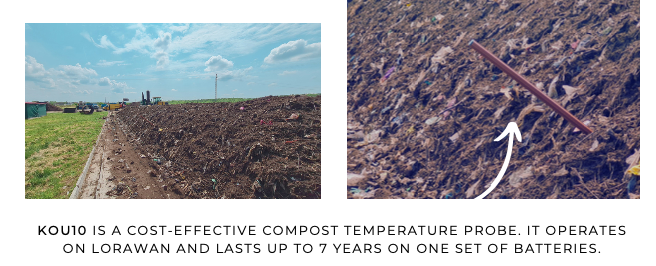
Temperature Measuring At Waste Management Site
COMPOSTING DEPENDS ON TEMPERATURE
Compost has to be monitored throughout the whole process. The rate at which composting occurs depends on physical and chemical factors. Temperatures above 65 °C burn carbons and turn into ‘invaluable ashes’.
Producing high-quality compost requires the employment of specialized personnel. While temperature readings seem simple, it takes a lot of time for a worker to constanty stuff the temperature probes into compost piles.

COMPOSTING IN THE IOT ERA
The IoT monitoring system provides real-time and continuous temperature monitoring to optimize the transformation process of biowaste into compost. Wireless temperature probes which are dug into piles at different depths, allow you to monitor your compost piles continuously and effortlessly without being tethered by cables. The temperature history gives a complete view of the composting process from fermentation to curing and maturation.
Producing high-quality compost requires the employment of specialized personnel. While temperature readings seem simple, it takes a lot of time for a worker to constanty stuff the temperature probes into compost piles.

USER BENEFITS
Comparing different types of compost temperature-checking solutions brings up an obvious advantage to the automated readings provided by IoT smart sensors. A simple calculation shows that labor costs over a 5-year period, result in extremely high expenditures.
While temperature readings seem simple, it still takes a lot of time for a worker to go around the compost area and stuff the temperature probes into compost piles. Because the temperature changes during the day, I presumed it takes about half a person to do that constantly (having the other half for other activities).
IoT sensors provide automatic readings, but there are other costs that have to be taken into account. The probes themselves are more expensive, there has to be some kind of software or middleware installed in the base computer to provide the readings. Then there is also battery life.
If we compare WiFi or cellular to LoRaWAN, there is also a noticeable edge on the side of high performance, low power, and affordable connectivity. LoRaWAN networks provide long-range, low-energy use readings which result in almost maintenance-free operation over a 7-year battery lifetime. They also have a significantly longer range (up to 50km) which means there can be only one gateway installed over a large compost management area.







